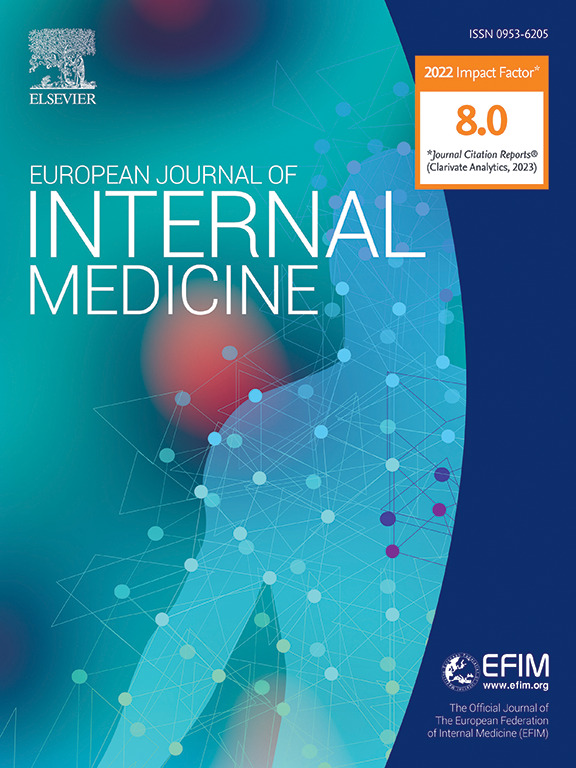惠普尔病的孤立关节累及:一项队列研究
IF 5.9
2区 医学
Q1 MEDICINE, GENERAL & INTERNAL
引用次数: 0
摘要
背景:分析惠普尔病的关节表现,比较临床孤立性关节受累(CIJI)与系统性关节受累(SJI)。方法:一项队列研究包括在两个专家中心诊断为惠普尔病和联合参与的患者。根据诊断时的临床表现将患者分为CIJI组和SJI组。结果:60例患者中,17例(28%)表现为CIJI。两组主要为中年男性(75%),中位诊断时间为6(2-11)年。关节受累相似,初始发作性迁移性关节炎(91%)主要影响大关节,持续2-7天。CIJI患者唾液和粪便PCR检测阳性的比例分别为59%和75%,而SJI组为91%和88% (P = 0.02和P = 24)。在CIJI患者中,65%的十二指肠PCR呈阴性,PAS染色持续呈阴性。100%的CIJI和89%的SJI患者的滑液PCR阳性。52例(88%)患者接受强力霉素和羟氯喹治疗后,除1例破坏性关节炎患者外,其余患者的关节症状均在10(7-15)天内得到缓解。结论:惠普尔病可表现为孤立的关节形态。联合参与通常是初始的和刻板的,CIJI和SJI之间几乎没有区别。诊断应考虑到复发性间歇性大关节关节炎的典型模式,急性期反应物升高,特别是在中年男性。滑液PCR是一种有价值的诊断工具。多西环素和羟氯喹显著改善。本文章由计算机程序翻译,如有差异,请以英文原文为准。
Isolated joint involvement in Whipple's disease: a cohort study
Background
To analyse the joint manifestations of Whipple's disease and compare clinical isolated joint involvement (CIJI) with systemic joint involvement (SJI).
Methods
A cohort study included patients diagnosed with Whipple's disease and joint involvement at two expert centres. Patients were divided according to their clinical presentation at diagnosis: those with CIJI and those with SJI.
Results
Of the 60 patients, 17 (28 %) exhibited CIJI. Both groups were predominantly middle-aged men (75 %) with a median time to diagnosis of six (2–11) years. Joint involvement was similar, with initial episodic migratory arthritis (91 %) predominantly affecting large joints and lasting 2–7 days. Saliva and stool PCR tests were positive in 59 % and 75 % of CIJI patients, respectively, compared to 91 % and 88 % in the SJI group (P = 0 02 and P = 0 24, respectively). In CIJI patients, duodenal PCR was negative in 65 % of cases and PAS staining consistently negative. Synovial fluid PCR was positive in 100 % of CIJI and 89 % of SJI patients. Treatment with doxycycline and hydroxychloroquine, initiated in 52 (88 %) patients, resulted in resolution of joint symptoms within ten (7–15) days in all but one patient, who had destructive arthritis.
Conclusion
Whipple's disease can present with isolated articular forms. Joint involvement is usually inaugural and stereotypical, with little difference between the CIJI and SJI groups. The diagnosis should be considered in cases with the typical pattern of recurrent intermittent large joint arthritis with elevated acute phase reactants, particularly in middle-aged men. Synovial fluid PCR is a valuable diagnostic tool. Doxycycline and hydroxychloroquine resulted in dramatic improvement.
求助全文
通过发布文献求助,成功后即可免费获取论文全文。
去求助
来源期刊
CiteScore
9.60
自引率
6.20%
发文量
364
审稿时长
20 days
期刊介绍:
The European Journal of Internal Medicine serves as the official journal of the European Federation of Internal Medicine and is the primary scientific reference for European academic and non-academic internists. It is dedicated to advancing science and practice in internal medicine across Europe. The journal publishes original articles, editorials, reviews, internal medicine flashcards, and other relevant information in the field. Both translational medicine and clinical studies are emphasized. EJIM aspires to be a leading platform for excellent clinical studies, with a focus on enhancing the quality of healthcare in European hospitals.

 求助内容:
求助内容: 应助结果提醒方式:
应助结果提醒方式:


